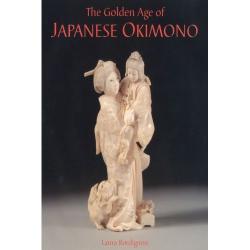The Golden Age of JAPANESE OKIMONO, Dr A.M. Kanter’s Collection

Antique Collectors’ Club, pages 302, copiously illustrated with colour plates
ISBN 978-1-85149-609-9
Review by Sir Hugh Cortazzi
Laura Bordignon is an antique dealer who has developed a close interest in the arts and crafts of the Meiji era. Dr Kanter has collected many fine pieces of ivory carvings made by Japanese artists and craftsmen in this period. His collection focuses on the elaborate ivory carvings called okimono (literally put or placed objects) although it also contains a number of items in metal, cloisonné and lacquer. In addition to coloured illustrations of objects in Dr Kanter’s collection the book includes a list of ivory carvers in the Tokyo Sculptors, Society with the characters which they used for their names, a list of Shibayama craftsmen, a note about Japanese signatures and an analysis of the different types of ivory used by Japanese carvers.
As Bordignon points out Japanese craftsmen who had devoted much of their energies to producing swords and sword fittings were deprived of this market following the prohibition on the wearing of swords in the early Meiji period. Instead they began to make pieces for western visitors and for the burgeoning trade in Japanese curios. Netsuke were still produced but carvers began to produce larger pieces for export. Craft goods in ivory, metal, cloisonné, lacquer and ceramics indeed formed a major element in Japanese exports in the last decades of the nineteenth century.
Ivory carving requires great skill and patience. It is also very time consuming. Japanese carvers showed exquisite workmanship in the many examples illustrated in this book. The first section of illustrations of okimono is devoted to depictions of various artisans at work. This is followed by a section of carvings of farmers performing various agricultural tasks. Another section is devoted to animals. These are followed by carvings of Japanese beauties (bijin) , samurai, entertainers and of mythological scenes. The final section devoted to okimono, headed ‘miscellaneous’, covers carvings which do not fit into any of the other categories
The objects depicted in this well illustrated volume may not appeal to all collectors. Those brought up to believe that the finest Japanese art is restrained and shibui may in particular find these highly decorative pieces over-ornamental, but everyone who sees these objects and looks at this volume must be impressed by the workmanship and skill of the Japanese craftsmen as well as by their imaginative and artistic depiction of the personalities and scenes which they carve.

